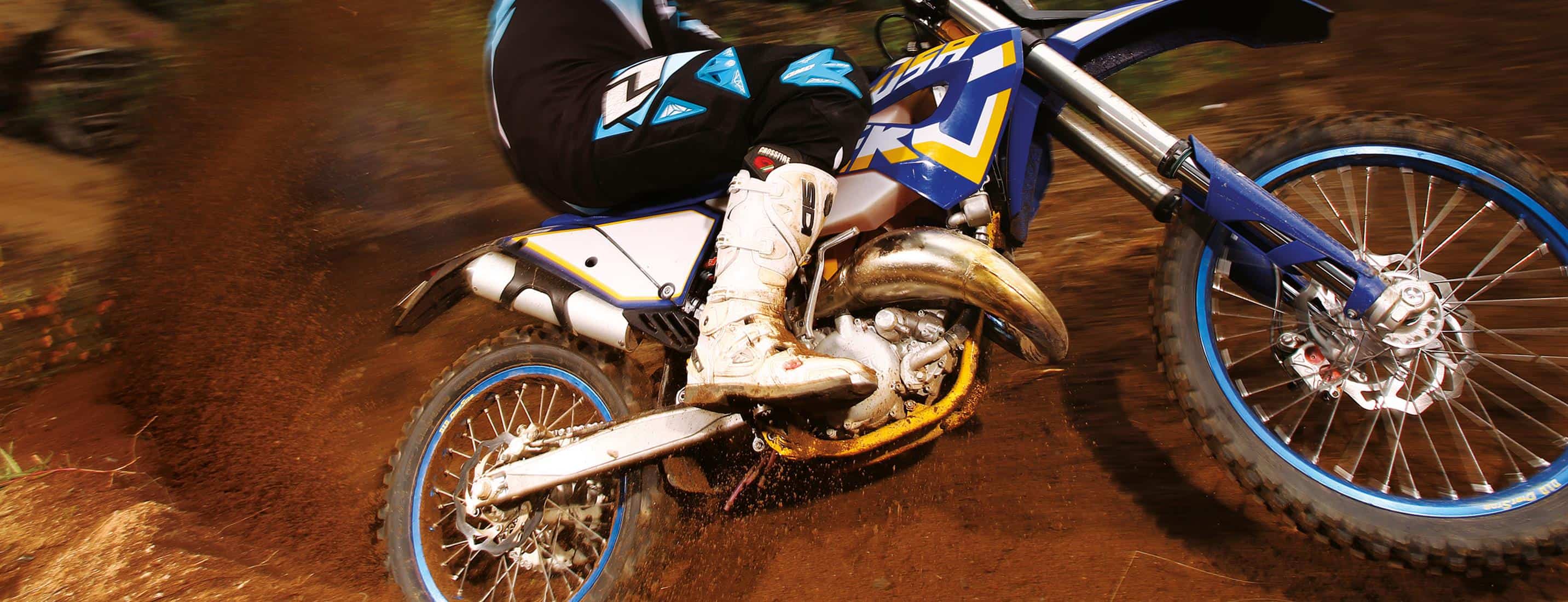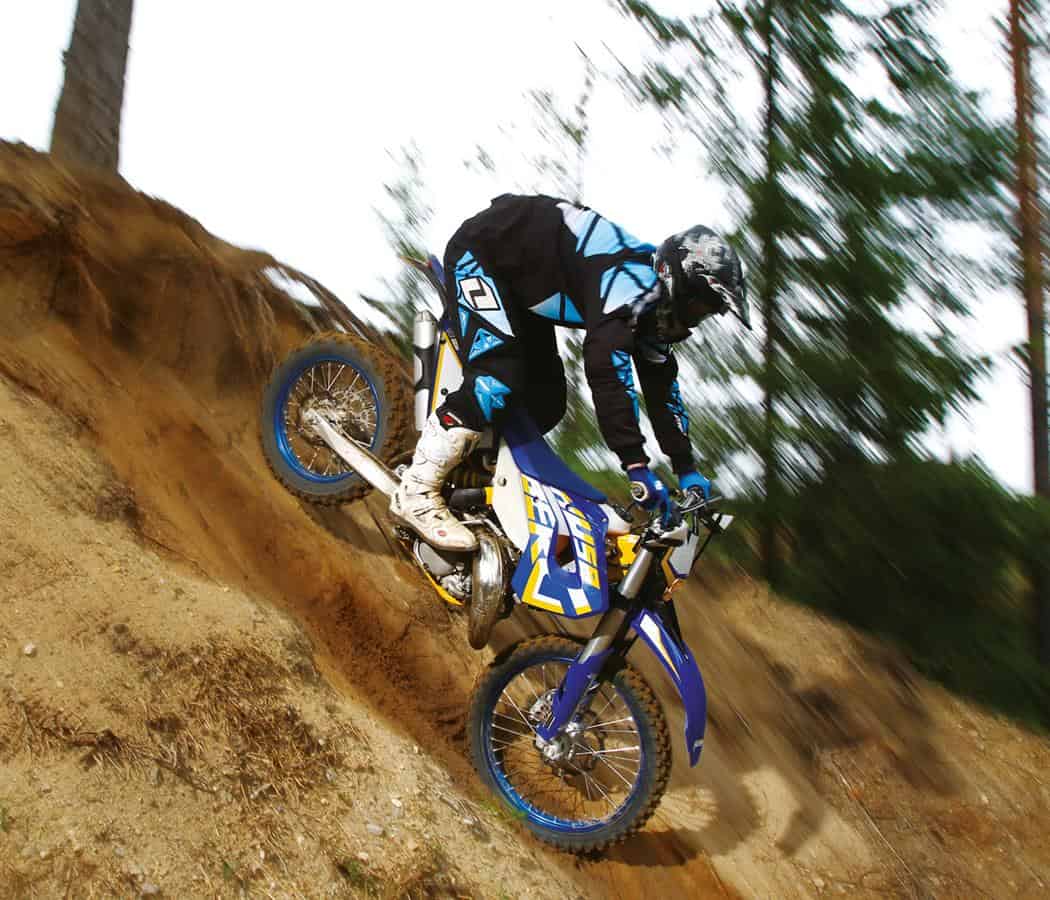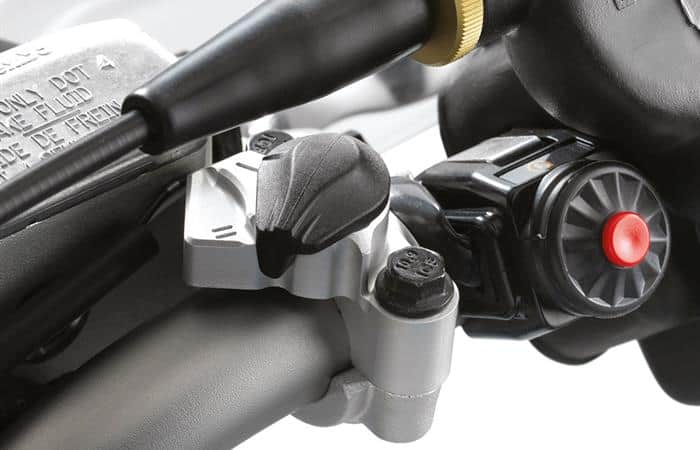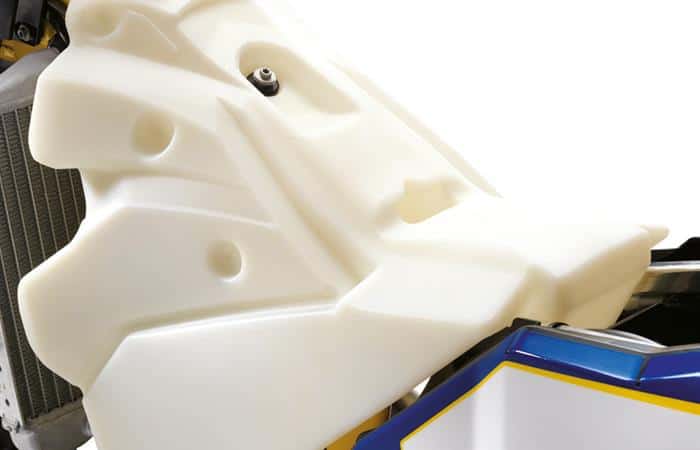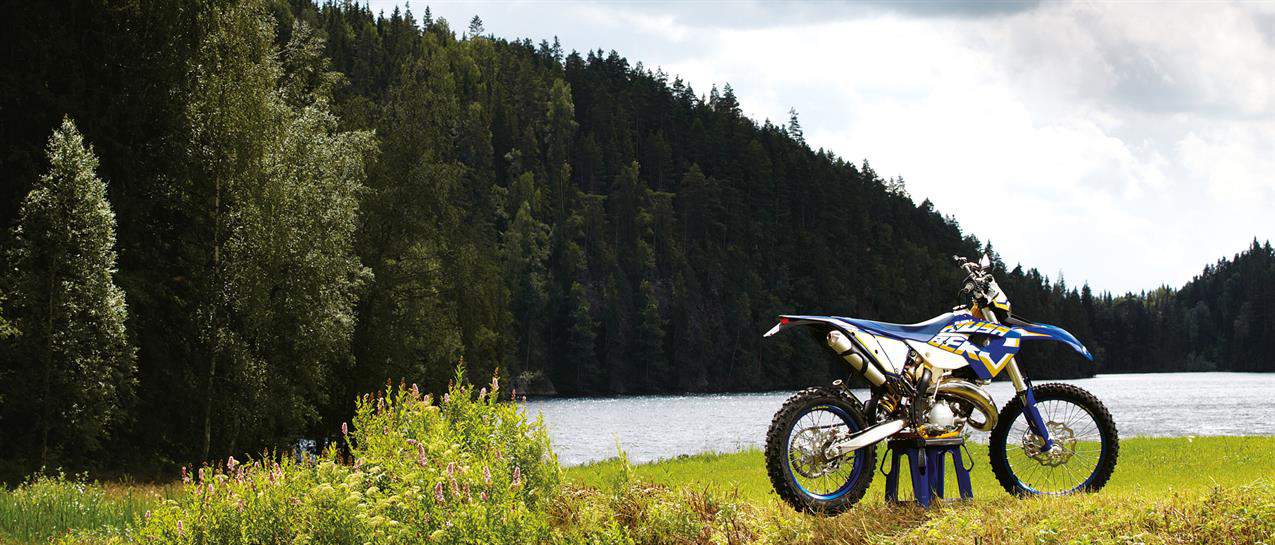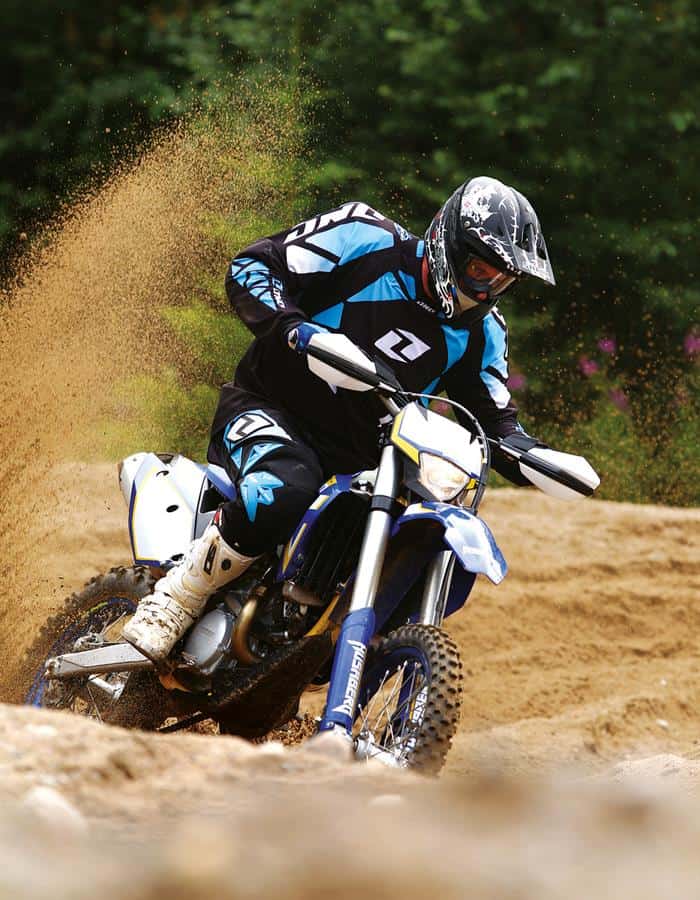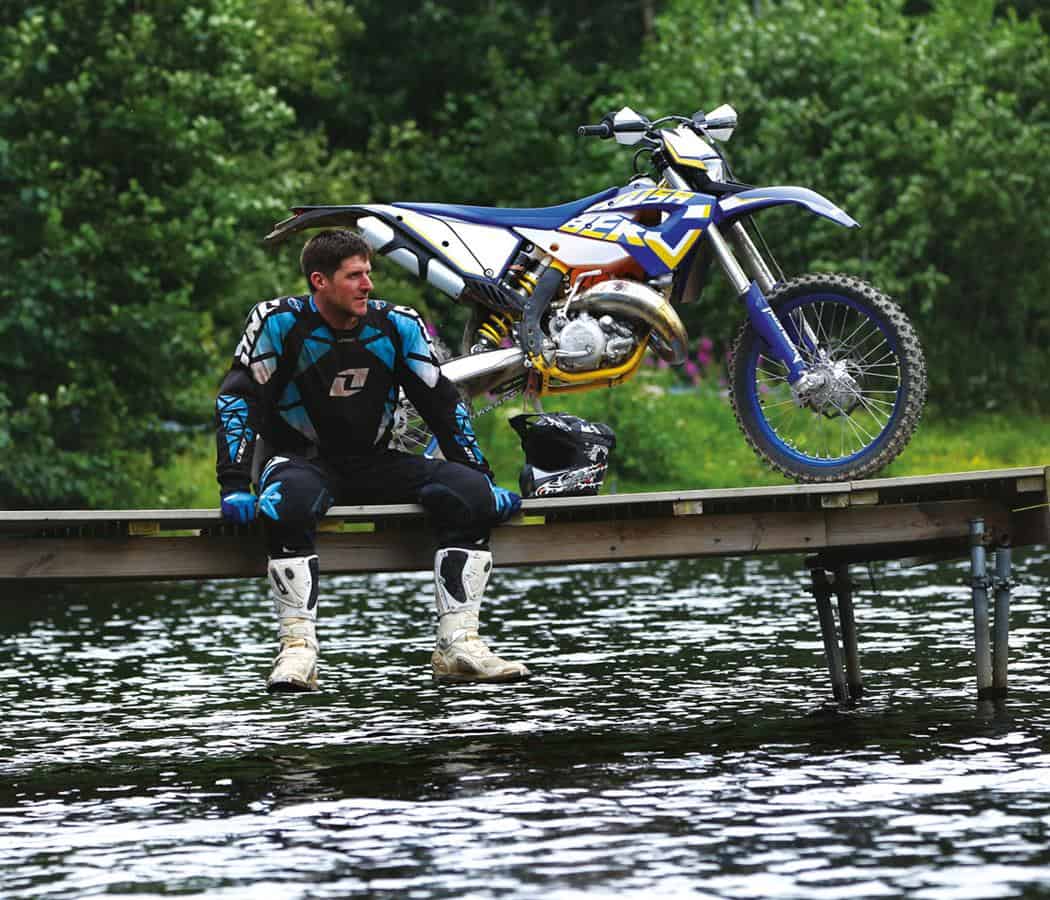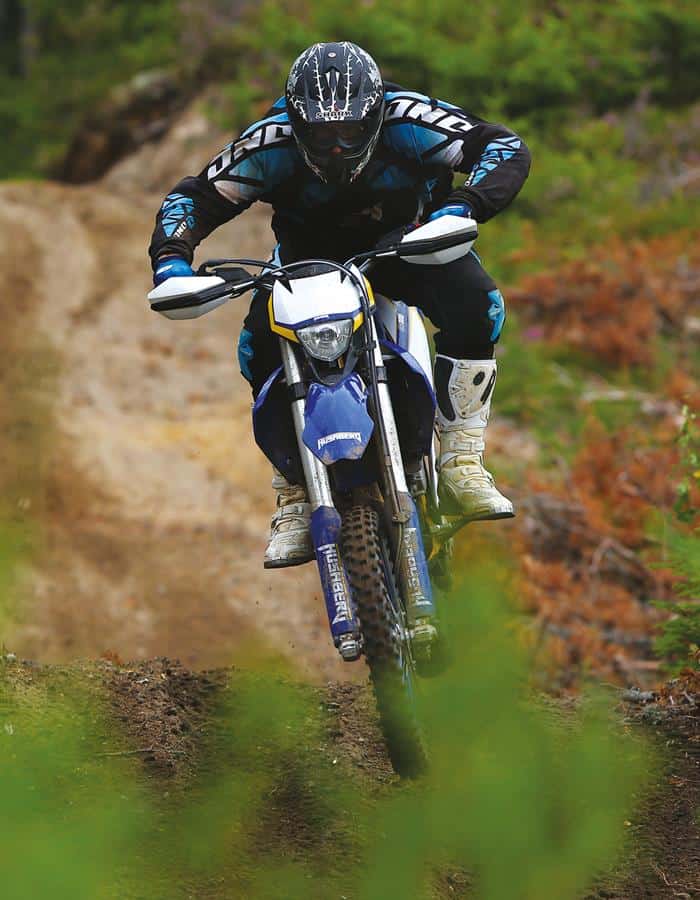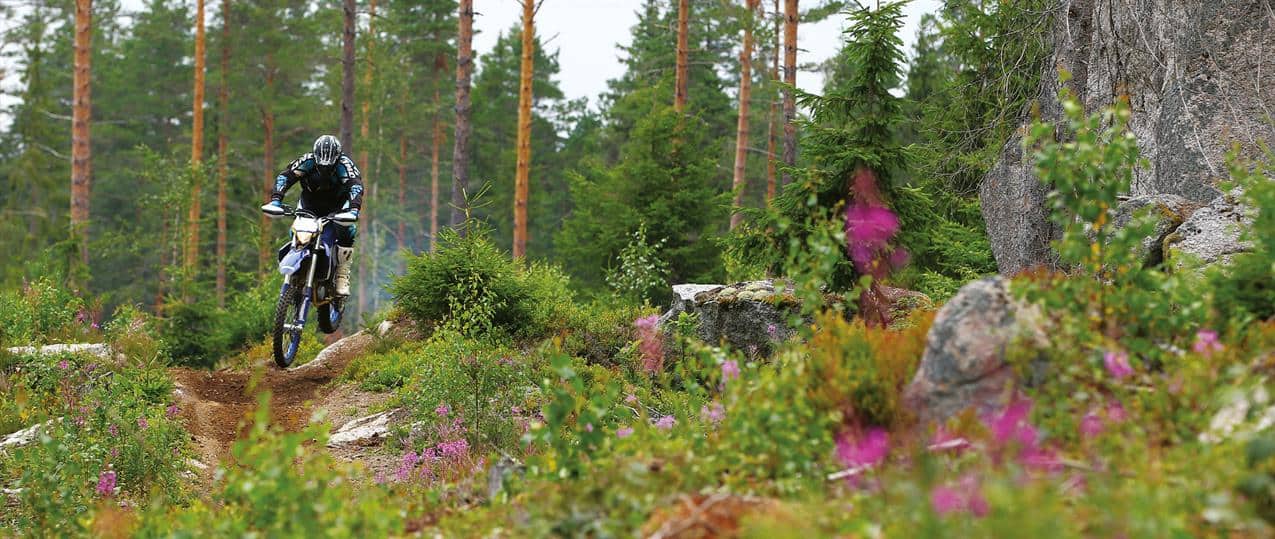Husaberg’s 2012 line-up now includes a new two-stroke, as Justin ‘Forest Chump’ Kingwell reports…
Husaberg launched their 2012 range last week in Sweden at Loka Brunn. In the heart of the forest and only a short distance from where the company still keeps its R&D facility and factory race team headquarters. KTM now manufacture the bikes alongside their existing range, but the strong connection with the birthplace of the brand is hugely important to them and maintains the ‘Husability’ that boss Oliver Goehring was keen to describe prior to testing the bikes.
‘This word will become known to riders everywhere – to mean easy, smooth riding, excellent handling and very important – useable power!’ – he announced. I soon found out that this was not some phrase dreamt up by a marketing expert, he really meant it.
The new company strategy is ‘100% enduro’. No more supermoto models, no road bikes, no trail bikes. The future product line will only feature enduro race bikes for clubmen to expert riders, E1, E2, E3 and extreme events. It’s clearly a strategy that works. 26 unbeaten Swedish National Enduro victories for Joakim Ljunggren, first at Romaniacs thanks to Graham Jarvis, a double podium at GP Romania, outright victory at Extreme Lagares and an almost certain victory at Erzberg Rodeo before a missed time check cost them the win, these are just some of the recent successes.
Oliver was also keen to point out that a return to ‘the inner core’ of the company – who made their first enduro bike in 1988 – would also include models for the younger rider entering the sport and that all models would be competitive, but would also be suitable for clubmen and intermediate riders. With hard economic times looming ahead, catching riders young and keeping them loyal to the brand as they progress, is clearly on the agenda.
Apart for the completely new TE125, changes for 2012 on the existing range are relatively few – an indication of the ‘if it ain’t broke, don’t fix it’ mentality that’s been forced on manufacturers right now. Nice new graphics and yellow frames cover the pretty bits. Translucent tanks are a no-brainer, along with fuel level sensors for the 4-strokes and larger fuel capacity for the 2-strokes to match the range of the thumpers
CNC machined triple clamps reduce weight and improve steering feedback and sensitivity – more of this later. Hand and frame guards that actually work – the former now in a dual-compound and mounted directly to the lever and master cylinders to help survive crashes and protect the riders hands instead of just pinging-off at the first sign of trouble. Michelin EC FIM Tyres as standard on all models ‘because they win!’ declared Joachim Sauer, Ex-Enduro Champion and now production manager at the KTM factory.
The factory have a policy of direct rider input with the brand development and with no less than two current and three past champions working directly alongside development and production, ‘Husability’ seems guaranteed long into the future.
Oliver talked a lot about the global recession and the effects on manufacturing and sales. Over a beer that night, I discussed with him how he saw the future. He summed it up like this: ‘We are a small dragon boat in stormy seas, looking for calmer waters’. He also pointed out that it was no good making the finest, most technically advanced bikes – that were then unaffordable to riders entering the sport or that would put off potential riders who would be curious to swap from their existing brands.
Ultimately, ownership by KTM has bought the ability to confront these issues by ensuring production costs, quality and volumes can be controlled, whilst development can be continued and costs can be shared between brands. The ability to employ top-quality factory riders to raise brand-awareness and concentrating on extreme events also keeps the brand profile high and reassures the buying public that their hard-earned cash will buy something that actually works and is a viable, technically different alternative to KTM. Take a note Suzuki please.
TE300
We started from Loka Brunn and headed for the test area some 10km away, with the works and factory riders leading us out in two groups. I grabbed a TE300 2-stroke (‘Wise choice’ Joachim Ljunggren commented with a wry smile…) and set off behind Thomas Gustavsson, 56 years old and a former 125 and Six-Day champion. Lots of people live in the forest in small villages and Swedish rural areas have thousands of miles of gravel roads and tracks away from the main highways. Good times!
We were warned to keep on the right hand side of ANY track, path or road AT ALL TIMES to avoid meeting occasional four and two wheeled on-coming traffic head-on. Bad times!
This immediately turned a 3m-wide forest track with a grass centre-strip into a 1m-wide gravel ribbon to ride on, with wet grass either side. On the sides of all the larger tracks are deep ditches for drainage and snow-melt water, littered with tree stumps and large sharp rocks. If by some miracle you survived these angry objects, a wall of Pinus Sylvestris (that’s large conifer trees to you) were always waiting to give you a nice woody cuddle.
‘No worries, I’ll stick behind the old guy’ I thought. Here began the first stage of my education using the ‘Husability’ method. It’s a good job I jumped in behind Tommy as the pace was immediately lifted to ‘bloody hell – that was close!’ as I shut everything else out of my mind to try and keep the old guy in sight.
The plus side of this exercise was to show me just how good the 300cc stroker was on fast going. It effortlessly pulled Tommy on the FE390, back into range on the faster straights and was so predictable and torquey in the corners that I was able to drift the rear wheel with my feet still firmly on the pegs. The handlebar-mounted switchable ignition enabled either ‘soft’ or ‘hard’ ignition maps at the flick of your thumb and the riding geometry was perfect to stand upright for long periods.
The low, flat seat enabled rapid movement and shifts of weight on the occasions when unexpected, terrifyingly fast corners and blind crests demanded emergency responses. These occasions occurred roughly every couple of minutes. We then stopped in a clearing and waited for some of the other members of our group who had fallen out the back of the Tommy Train.
‘Goot verk, big man’ said Tommy. I grinned, wiped the sweat from my eyes, waited for my pulse to come down from valve-float levels and rested my madly shaking hands in my lap, so they couldn’t be seen and mumbled ‘thanks’. Once re-grouped we headed into a very tight bit of forest singletrack, more suited to dog walking than riding. I hate this type of riding as I usually associate it with pain and suffering, but I stuck the big 300 into second gear and dived in.
This thing totally defies your expectations of it. It found endless grip over the wet roots and up the steep short climbs. I’m not a big clutch user and there was little need anyway, but when I did use it the super-light Magura unit required only my index finger for operation. This thing just chugged through whatever I pointed it at. Incredible. The balance of the whole package, along with brilliant brakes and the now-standard closed-cartridge 48mm WP forks (that’s no emulsifying of the fork oil and subsequent loss of damping to you and me), meant that every ripple, rock or root, sent back tons of feel to me to enable me to stay upright and moving at all times. Wow. My final sneaky test was to try and see how low I could wind down the motor before it stalled. This thing will pull fourth gear on tick-over. Right then, that’ll do for me.
TE125 and TE250
We arrived at the main test venue. This huge forest area chosen for the testing consisted of three distinct types of riding conditions. A long and tough MX track with deep sand, jumps and climbs in a traditional style (no big tabletops or gap-jumps), a 50 acre ‘rock garden’, with tough and technical trials-style riding and deep natural sand quarry-style holes with vertical drops and lastly a singletrack loop that was as good as anything that I have ever ridden before.
Miles of endless rolling track with banked turns, step-ups and downs, log bridges and brilliant sections of perfectly laid-out rolling natural whoops and turns. If you sat down and listed your fantasy riding track, this would be pretty close. This also happens to be Joachim’s Ljunggren’s training area. Jammy git.
With three of every model to choose from and a large, friendly and helpful support crew to keep things ship-shape, the organisation was very KTM. After a short briefing, I grabbed the TE125 and headed out into the deep sand of the MX track to get the worst over with first. Straight off the superb TE300, I was expecting a vicious screamer with a narrow powerband. A claimed 37hp in stock trim and 95kg weight without fuel seemed a tall order to deliver a useable package, but by the first corner, I was hooked. It genuinely feels like a 200cc motor. Scratch that. It’s like a mountain bike with an engine!
I had set off with a handful of revs and lots of clutch and dived into a corner too fast and tipped over. It was only when I tried to get going again in the deep sand that I realised that it would pull from low revs. Easy. Let it chug along with one-third revs and then open the taps for more go when required. This was a genuine revelation for me. A 125 that can be ridden slowly? Surely not?
After a couple more laps I headed off the MX loop into the singletrack. This bike is like a mini TE300. It is so light and manoeuvrable, so easy to control, that I would happily trail ride it. Even with the low-weight, there was no stutter or bouncing off rocks and roots. My 100kg definitely helped here, but what I am trying to say is that this is such a complete package, that it would suit any level of rider in almost any terrain, except long fast road sections where it needs to be thrashed mercilessly to keep up.
This was ably demonstrated by ‘Jochi’ Junior (Ljunggren) who then took my bike when I returned and demonstrated to stunned onlookers, just how fast it could be ridden. This consisted of holding it wide-open in fourth, fifth or top gear and simply altering speed and direction by fanning the clutch and leaning. It’s also worth pointing out that on the road and track sections later on, he was doing vertical wheelies in top gear for minutes at a time whilst leading the rest of us back to Loka Brunn, though I wouldn’t recommend this treatment for long-term engine reliability.
After his MX display, I took it straight off him to do another lap and it felt exactly the same. No rattles, no fried brakes and just sat ticking over like nothing had just happened. It’s also worth pointing out that I tried the unique JK test of thrashing it for half a lap, stopping and laying on its side in gear until the engine eventually cut out. I then picked it up and tried to start it, in gear, with the clutch pulled in. Instant results and off I went.
I personally think that this type of re-start loses the most time for any rider. How many occasions have you seen, or been stuck behind, some poor rider trying to re-start (in gear) a red-hot bike that’s stalled? How many times has this been you? Rest assured. I tried this with every model in the range and without exception, they all passed. No need for some hot-start lever or hard to remember sequence.
Just flip out the low slung lever and give it a prod with an open throttle with the 125. Simples. On the 250 and 300, just press the button. What joy. On the FE 4-strokes, they start so easily and quickly in any situation that I simply gave up caring what I did and started to take huge liberties with them as I knew that they would just bark back into life in a nano-second whenever required.
From then on I never stopped in neutral or even bothered to try and find it as there is simply no need. Take note everybody that from today, if you wish to receive a satisfactory review by JK of your new motorcycle, please ensure that it starts exactly as described above. I am now simply not interested in ANY bike that does not do this. You have been warned.
After a while I pulled in and grabbed the TE250. What to make of this one? Well, within five minutes I had the answer. Mountains of torque, slightly more snap in the power delivery than the 300, even in ‘Soft’ ignition mode (yes, it too has the magic switch) and enough power to easily keep up with anything out there when required. A more aggressive riding position and what felt like a quicker turning chassis completed the package.
The 250 will suit the rider who is a fast clubman or better, and who wants to do occasional trail rides or three-day trips to France. Buy the 300 if it’s the other way round and you only do a couple of events a year, but spend most weekends on the trail, or if your name is Graham Jarvis and you want to blitz the opposition! Seriously, these strokers really are the complete package and with cheaper purchase and running costs than the thumpers, make good economic sense for those aiming to keep costs down.
FE390, FE450 and FE570
The four-strokes need to be a bit special to tempt buyers into raising the extra cash I thought. Firstly, let’s look at the main ‘Husability’ ingredient of these three models – the 70-degree engine. When I first pictured the bikes with the new design, I genuinely could not see why they had done it. Do they really turn quicker? Is that added ground-clearance a real deal-breaker? Is the improved service access really that important? Can moving the rotating crankshaft to the centre of balance of the whole bike really make the advances they claimed?
Quite simply, the answer is yes. I grabbed an FE390 at random and ripped out onto the now familiar MX track. By now, I was getting very tired and had had a big off trying to jump the 125 into the one of the sand holes, trying to follow one of the works guys, followed by a nice backflip on to my, er… back attempting to get back out again, so I was also sore and tired. But this thing is so easy to ride! Think where you need to be, point the front wheel, make sure you are in some type of gear and open the throttle.
Let your attention drop to look at a view to one side, notice a corner that is tighter than it looked 50m back, jab the rear brake, pile the thing in and then snap open the throttle and simply proceed to the next corner, obstacle or whatever. It really is that easy. Add a super-light clutch and the ability to trickle over huge rocks without banging the frame, an engine that absolutely refuses to stall and you are now getting the picture. Man, I love two-strokes, but this bike could tempt me.
It was a tad too cramped for me when standing, but a simple bar riser kit would soon sort that and the fact that three of the factory riders had a 390 as their personal bikes summed it up nicely.
Alternatively if you’re 25 to 35 years old, a fit and strong rider who likes to really open the taps, with above average ability and are able to hustle a bike along at life-threatening speeds, then buy the 450 rather than the 390. Like its smaller brother, but with just a bit more of everything. I’m not knocking the factory for this model, but with the 390 being SO good, the 450 is slightly nudged to the side in terms of relevance.
Brilliant fun to ride on the open going and the road. I laughed myself stupid on the way back to the hotel following Tommy doing top-gear wheelies along the highway. The FE570? Okay I confess I only rode this along the wide-open main tracks for a short time until we stopped at a scenic lake for a few group pics on a wooden jetty. It is way more powerful and faster than anyone needs. In fact I don’t mind admitting that it scared me a little at times.
As soon as we stopped, a Finnish journo called Pratenen walked straight over and just said, ‘Give me your motorcycle’. It was like the scene from T2, when Arnie walks naked into the bar and lifts the Harley, clothes and gun from the biker. Okay he didn’t take my clothes and I didn’t have a gun, but you get the picture. The next 20km back to the hotel demonstrated just what one of these can do in the right hands. Full-lock drifting at 100kph on wet gravel tracks and stand-up wheelies flat-out in top gear on the main roads, including round the corners. Wow. I can’t really think why you would ever need one of these, but if you do buy one, put on your happy face and find a bolt-hole to hide from the cops!
Conclusion
Like most people, you probably have your own views on what is good, bad or otherwise when it comes to dirt bikes – I’m the same as you. I try to be as fair and objective as I can when I write about stuff, but it remains a straightforward fact that there really isn’t a bad bike here. I wouldn’t pick a 570 as my first choice, and though the new TE125 was the most remarkable machine of this bunch, my age weight and size would steer me towards something bigger if it was my own cash.
So I’ll take a TE250 two-stroke thanks very much, and an FE390 thumper for the very best of both worlds. Husability… dumb word. Smart choice!
Thanks to: Joachim Sauer, Eva Priewasser, Oliver Goehring, Joachim Ljunggren and all the numerous other people who helped out on the Berg launch. Cheers guys.

